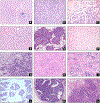Breast Cancer Subtypes: Clinicopathologic Features and Treatment Considerations
- PMID: 40574868
- PMCID: PMC12199283
- DOI: 10.1007/s12609-024-00541-6
Breast Cancer Subtypes: Clinicopathologic Features and Treatment Considerations
Abstract
Purpose of review: The purpose of this review is to provide an overview of ten unique breast cancer subtypes and their clinicopathologic features and treatment implications.
Recent findings: Recent findings show that while many subtypes (mucinous, papillary, tubular, apocrine) have favorable biology, with better overall survival than invasive ductal carcinoma, some (metaplastic, adenoid cystic) are more aggressive portending worse prognosis for patients.
Summary: The differences in histology represented in these breast cancer subtypes often impacts biology, behavior, and prognosis. Due to their rarity, additional research is needed to implement clear treatment protocols for each subtype.
Keywords: Apocrine carcinoma; Breast cancer subtypes; Metaplastic; Mucinous; Papillary.
Conflict of interest statement
Conflict of Interest The authors declare that they have no conflict of interest.
Figures

Similar articles
-
A rapid and systematic review of the clinical effectiveness and cost-effectiveness of paclitaxel, docetaxel, gemcitabine and vinorelbine in non-small-cell lung cancer.Health Technol Assess. 2001;5(32):1-195. doi: 10.3310/hta5320. Health Technol Assess. 2001. PMID: 12065068
-
Special subtypes with favorable prognosis in breast cancer: A registry-based cohort study and network meta-analysis.Cancer Treat Rev. 2020 Dec;91:102108. doi: 10.1016/j.ctrv.2020.102108. Epub 2020 Oct 9. Cancer Treat Rev. 2020. PMID: 33075683
-
Prophylactic mastectomy for the prevention of breast cancer.Cochrane Database Syst Rev. 2004 Oct 18;(4):CD002748. doi: 10.1002/14651858.CD002748.pub2. Cochrane Database Syst Rev. 2004. Update in: Cochrane Database Syst Rev. 2010 Nov 10;(11):CD002748. doi: 10.1002/14651858.CD002748.pub3. PMID: 15495033 Updated.
-
Hormonal therapies for early breast cancer: systematic review and economic evaluation.Health Technol Assess. 2007 Jul;11(26):iii-iv, ix-xi, 1-134. doi: 10.3310/hta11260. Health Technol Assess. 2007. PMID: 17610808
-
Molecular feature-based classification of retroperitoneal liposarcoma: a prospective cohort study.Elife. 2025 May 23;14:RP100887. doi: 10.7554/eLife.100887. Elife. 2025. PMID: 40407808 Free PMC article.
Cited by
-
National trends in neoadjuvant systemic therapy utilization in patients with early-stage HER2-positive breast cancer from 2016-2021: The impact of the KATHERINE trial.Breast Cancer Res Treat. 2025 Aug;212(3):531-543. doi: 10.1007/s10549-025-07750-2. Epub 2025 Jun 3. Breast Cancer Res Treat. 2025. PMID: 40459676
References
-
- Krompecher E. Apocrine carcinoma of the breast. Beitr Path Anat. 1916;62:403.
-
- Frable WJ, Kay S. Carcinoma of the breast. Histologic and clinical features of apocrine tumors. Cancer. 1968;21(4):756–63. - PubMed
-
- Tan PH, Ellis I, Allison K, et al. The 2019 World Health Organization classification of tumours of the breast. Histopathology. 2020;77(2):181–5. - PubMed
Grants and funding
LinkOut - more resources
Full Text Sources
Research Materials
